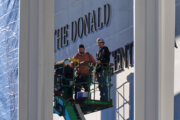WASHINGTON – An investigation into what caused a Green Line train to split into two parts earlier this month has led to two new inspection and servicing recommendations for Metro.
The agency’s head of transit infrastructure and engineering recommends new, more finite testing for a key part of train couplers and more frequent maintenance of pneumatic lines that can open the couplers.
In this case, the six-car train made up of 3000 series cars was headed northbound toward Navy Yard Station Jan. 6, when the cars automatically went into emergency braking.
Metro Assistant General Manager Andrew Off says the train operator followed correct procedures by going back to investigate the issue. The operator found the last two cars of the train about 18 inches away from the first four cars.
At the time of the incident, a Metro spokeswoman described the separation as being between the second and third cars of the train, not the second and third pairs of cars.
While there had been issues with electrical couplers on the train before it left the Branch Avenue yard, Off says the investigation found that those issues were properly corrected by maintenance crews.
“There was no observable damage to any components on either train or any part of the coupling assembly, and the incident was not caused by an inadvertent command to uncouple,” he told a Metro Board committee Thursday.
Instead, the investigation found that a spring that keeps the couplers closed was too flexible, and that there was water in the pneumatic lines that are used to open the couplers.
No one was hurt in the incident, but it contributed to major delays during the morning commute. The train “uncoupled” around 8:10 a.m., and was not moved into the Navy Yard Station to offload riders for 30 minutes.
The train then went to the Greenbelt train yard where the investigation began.
Off is recommending that the springs be tested with tools that give a precise number for the stiffness, rather than the current tools which simply rate the spring pass/fail.
“We need to implement a tool that gives us a specific numeric parameter so that we can show that it’s either within range or it’s not within the range,” he says.
The second recommendation is to drain the air lines as a part of Metro’s daily service tests, rather than just once a year when cars are prepared for winter.
Off believes a similar incident happened on Metro’s main line tracks roughly 22 years ago.






